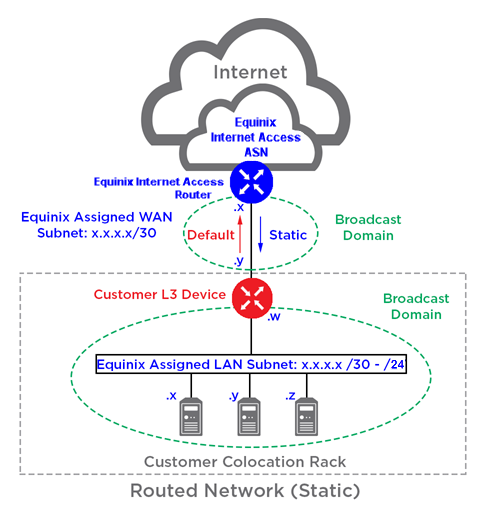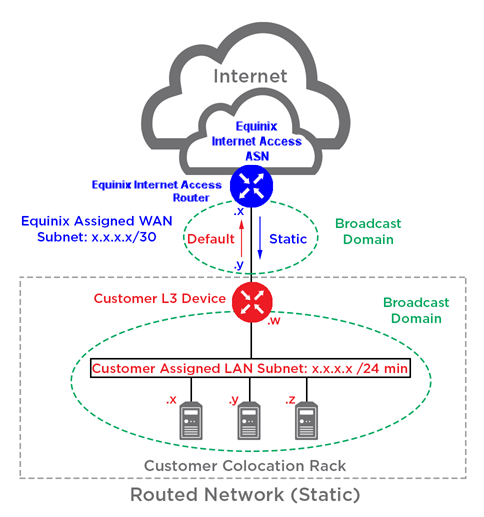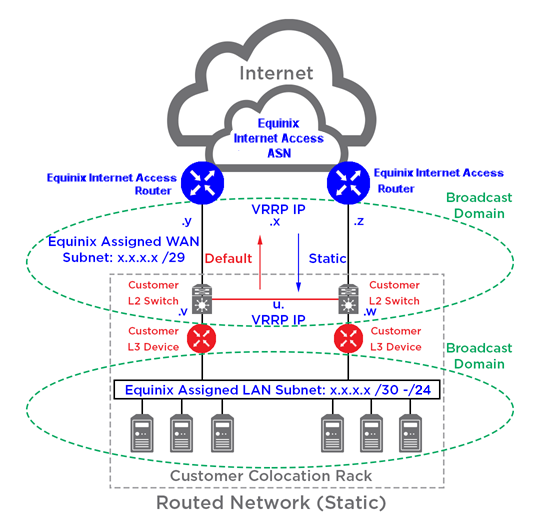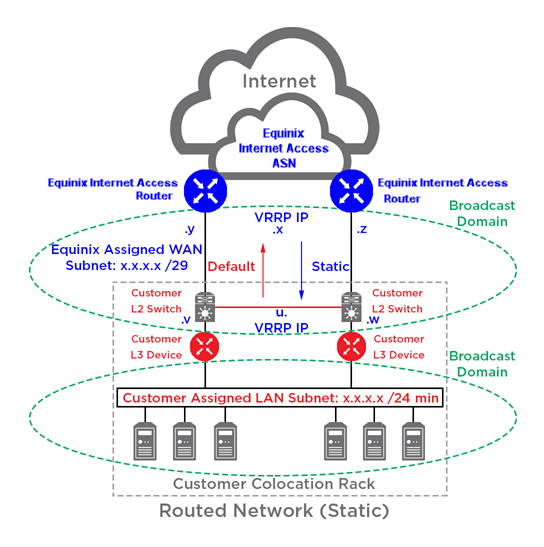Static Routing
With Static Routing, you maintain the routing table manually. Static routing is practical for a single network communicating with one or two other networks. However, as your network begins to communicate with more networks, the number of gateways increases, and so does the amount of time and effort required to maintain the routing table manually. Static routing is suitable for networks where the network topology is stable and changes are infrequent. It is also commonly used for specific purposes, such as routing traffic to a default gateway or configuring specific routes for security or performance reasons.
Static Routing supports Virtual Router Redundancy Protocol (VRRP).
Single-Port Architectures
Single-Port Static – Provider-assigned IP
This configuration requires a routed network set up. The default peering (WAN) IP addresses assigned are /30 for IPv4 and /64 for IPv6. You are required to provide a Layer 3 device.
You must purchase additional LAN IP subnets from Equinix for this option.

Single-Port Static – Provider-independent IP
This configuration allows you to use your own public IP addresses for the LAN. Your subnets must be a minimum of /24 for IPv4 addresses or /48 for IPv6 addresses. You must also have created a Route Origin Authorization (ROA) in an IRR database as described in Provider Independent IP Space.
The default peering (WAN) IP addresses assigned are /30 for IPv4 and /64 for IPv6.

Dual-Port Architectures
Dual-Port VRRP Static – Provider-assigned IP
This configuration requires a routed network setup. The default peering (WAN) IP addresses assigned are /29 for IPv4 and /64 for IPv6. You are required to provide a Layer 3 device.
- The first three octets are reserved for Equinix, in this order: Equinix VIP (customer gateway), Equinix PRI, Equinix SEC.
- The next three usable IPs are designated for your use.
- Your static routes are sent to the Customer VIP as the next hop.
Example:
| Network | 149.97.230.128/29 |
|---|---|
| Equinix VIP | 149.97.230.129 |
| Equinix PRI | 149.97.230.130 |
| Equinix SEC | 149.97.230.131 |
| Customer PRI | 149.97.230.132 |
| Customer SEC | 149.97.230.133 |
| Customer VIP | 149.97.230.134 |
You must purchase additional LAN IP subnets from Equinix for this option.
Protection switching is where your equipment switches based on monitoring hello messages. You provide the multi-access network (Layer 2 switching) required for VRRP advertisements between the primary router and the client.

Dual-Port VRRP Static – Provider-independent IP
This configuration requires a routed network set up, and allows you to use your own Public IP addresses for the LAN. Your subnets must be a minimum of /24 for IPv4 addresses or /48 for IPv6 addresses. You must also have created a Route Origin Authorization (ROA) in an IRR database as described in Provider Independent IP Space.
The default WAN IP addresses assigned are /29 for IPv4 and /64 for IPv6.
Protection switching is where your equipment switches based on monitoring hello messages. You provide the multi-access network (Layer 2 switching) required for VRRP advertisements between the primary router and the client.
